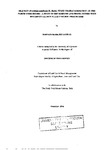BRACKEN (Pteridium aquilinum (L.) Kuhn) STAND CHARACTERISATION ON THE NORTH YORK MOORS: A STUDY OF THE RHIZOME AND FROND SYSTEM WITH REGARD TO A LARGE SCALE CONTROL PROGRAMME
| dc.contributor.author | HOLLOWAY, STEPHEN MARK | |
| dc.contributor.other | School of Geography, Earth and Environmental Sciences | en_US |
| dc.date.accessioned | 2013-11-19T08:40:02Z | |
| dc.date.available | 2013-11-19T08:40:02Z | |
| dc.date.issued | 1994 | |
| dc.identifier | NOT AVAILABLE | en_US |
| dc.identifier.uri | http://hdl.handle.net/10026.1/2750 | |
| dc.description | Merged with duplicate record 10026.1/777 on 15.02.2017 by CS (TIS) | |
| dc.description.abstract |
Large-scale rhizome sampling on the North York Moors together with an assessment of published bracken sampling protocols concluded that small-scale sampling of the rhizome system is inadequate to describe upland bracken stands accurately. It is also concluded that the frond cannot be used as an indicator of the rhizome system before or after treatment to achieve bracken control. An improved sampling strategy is proposed which increases the reliability of data collected and the validity of any conclusions drawn form such data. The structure of bracken rhizome systems, from separate stands on the North York Moors, were found to be distinct from one another and demonstrated intrinsic variation which could affect a differential response to control. The most important components of the rhizome system, when considering chemical control using asulam are: the number of buds likely to remain viable afterwards; the rhizome biomass which may effect herbicide dilution; and the origin of frond production which may affect herbicide distribution. The effect of asulam was to cause severe localised damage to buds and apices detectable one year after treatment but the rhizome dry weight remained unaffected. In one instance asulam appeared to have a stimulatory effect on bracken by breaking bud dormancy, this was related to the characteristics of the stand before treatment. It is recommended that the use of asulam is restricted to pioneer or building stands which have a high number of active buds in relation to dormant buds, and a low rhizome dry weight. Crushing bracken once a year effected a temporary reduction in rhizome dry weight, and an increase in frond number (which could improve asulam absorption). A combination of crushing and asulam reduced both bud number and rhizome dry weight and was thus the most successful treatment studied for reduction of bracken vigour. In particular, stands adjacent to valued plant communities should be targeted for control. It is suggested that bilberry could be used as a buffer zone between heather and invading bracken. The use of large-scale bracken control programmes in upland regions was questioned due to the apparent ineffectiveness of asulam on the rhizome system, and the difficulty of implementing a programme of successful follow-up and after-care management. A broad classification of upland bracken, based on the rhizome, was recognised, and general models of selective bracken control suggested, by evaluation of the rhizome system with regard to the number of dormant and active buds, and the rhizome dry weight. | en_US |
| dc.description.sponsorship | The North York Moors National Park | en_US |
| dc.language.iso | en | en_US |
| dc.publisher | University of Plymouth | en_US |
| dc.title | BRACKEN (Pteridium aquilinum (L.) Kuhn) STAND CHARACTERISATION ON THE NORTH YORK MOORS: A STUDY OF THE RHIZOME AND FROND SYSTEM WITH REGARD TO A LARGE SCALE CONTROL PROGRAMME | en_US |
| dc.type | Thesis | |
| plymouth.version | Full version | en_US |
| dc.identifier.doi | http://dx.doi.org/10.24382/4769 | |
| dc.identifier.doi | http://dx.doi.org/10.24382/4769 |
Files in this item
This item appears in the following Collection(s)
-
01 Research Theses Main Collection
Research Theses Main


